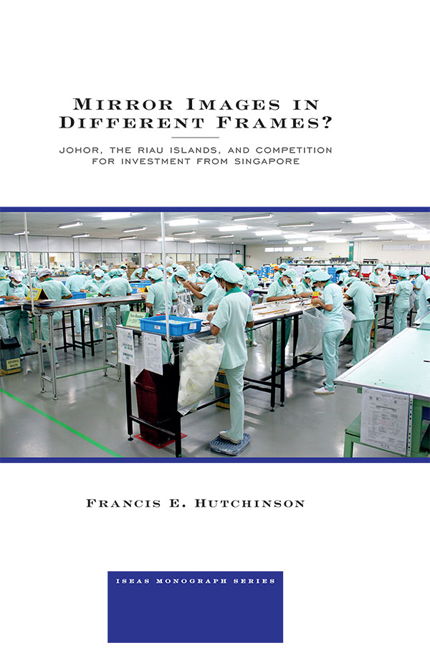 Mirror Images in Different Frames?
Mirror Images in Different Frames? Book contents
- Frontmatter
- Contents
- List of Tables
- List of Figures
- Editorial Note
- Acknowledgements
- About the Author
- List of Acronyms
- 1 Introduction
- 2 Theoretical Framework
- 3 “Internal State Architecture” and Incentive Structures for Meso-Level Leaders
- 4 The Cases: Johor and the Riau Islands
- 5 Conclusion
- Endnotes
- References
3 - “Internal State Architecture” and Incentive Structures for Meso-Level Leaders
Published online by Cambridge University Press: 15 November 2017
- Frontmatter
- Contents
- List of Tables
- List of Figures
- Editorial Note
- Acknowledgements
- About the Author
- List of Acronyms
- 1 Introduction
- 2 Theoretical Framework
- 3 “Internal State Architecture” and Incentive Structures for Meso-Level Leaders
- 4 The Cases: Johor and the Riau Islands
- 5 Conclusion
- Endnotes
- References
Summary
This chapter will compare and contrast the “internal state architecture” and incentive structures faced by meso-level leaders in Malaysia and Indonesia. This will be done to set out the environment in which meso-level leaders in the two countries choose priorities, formulate goals, and derive income.
Up until 1998, the two countries shared a number of significant institutional similarities. For much of their recent past, Malaysia and Indonesia have variously been termed as “authoritarian” (Pepinsky 2009, p. 40) or “semi” and “pseudo” democracies, respectively (Case 2002, pp. 29, 99). Both were characterized by considerable concentration of power in the executive, centralized bureaucratic decision-making “removed” from popular debate, de facto one-party political systems, and limits on political expression. It will be argued that the incentive structure this provided regional leaders was one heavily tilted towards national policies and priorities. However, this political incentive structure overlay an important distinction. Malaysia's fiscal structure contained an important indirect incentive for meso-level leaders to court investment and provide market-enhancing goods. Indonesia's did not.
The 1997 Asian Financial Crisis was a critical juncture for both countries, after which their respective political and institutional contexts developed in significantly different ways. While subjected to considerable stress, the Malaysian regime emerged largely intact, preserving the existing incentive structure. In contrast, Indonesia embarked on a far-reaching political reform process, of which decentralization was an integral part. The net effect has been to increase the autonomy of meso-level leaders and the weight of local-level issues in provincial policy-making. However, while the country's fiscal structure sees a greater quantum of resources being transferred to regional leaders, the new financial incentive structure does even less to reward initiative and financial self-sufficiency.
Malaysia
Malaysia has a federal system of government and many of the features of a parliamentary democracy. Its structure of governance is comprised of: a federal government and three federal territories; thirteen state governments; and approximately 150 local authorities. The country's constitution allocates responsibilities and revenue sources for the centre and states, with separate lists for unique responsibilities as well as a concurrent list for shared responsibilities.
Despite its formal identity as a federation, Malaysia's system of governance is “top-heavy” with a majority of responsibilities and revenue sources under federal control. Policy domains commonly associated with meso-level governments such as education, transport, and policing are attributed to the federal government in Malaysia.
- Type
- Chapter
- Information
- Mirror Images in Different Frames?Johor, the Riau Islands, and Competition for Investment from Singapore, pp. 19 - 38Publisher: ISEAS–Yusof Ishak InstitutePrint publication year: 2015


